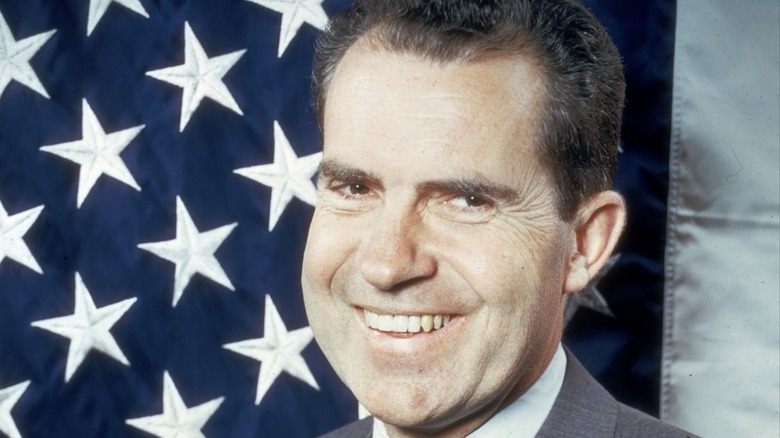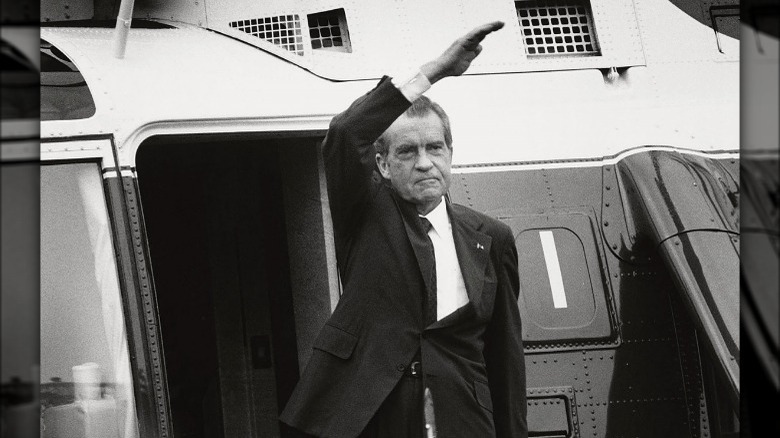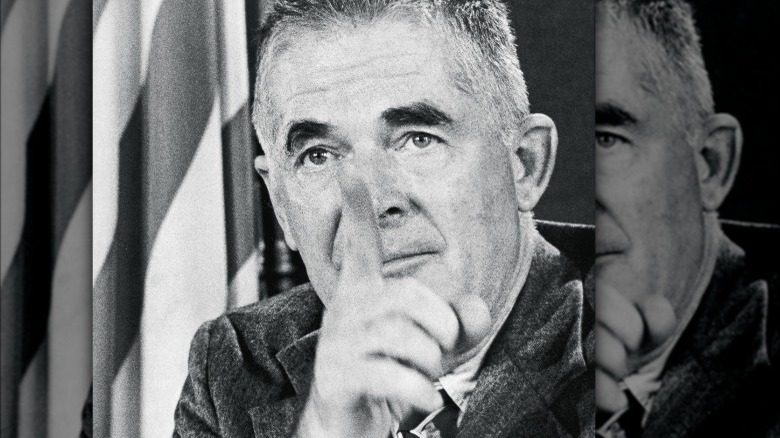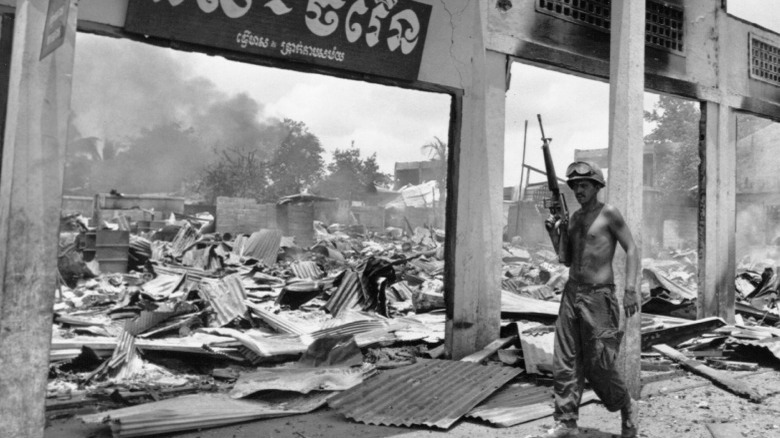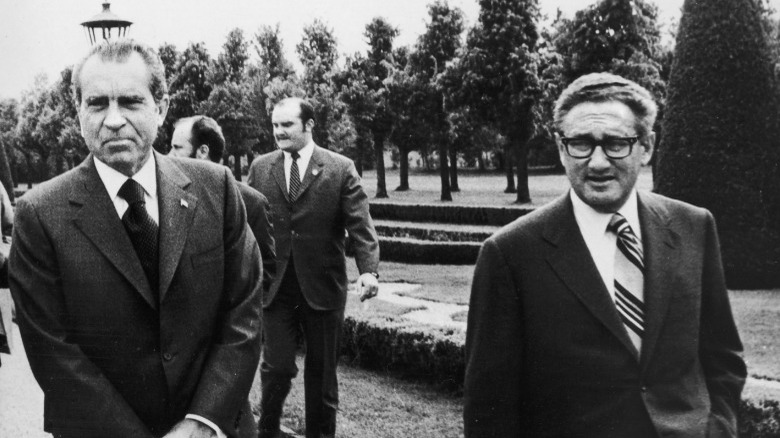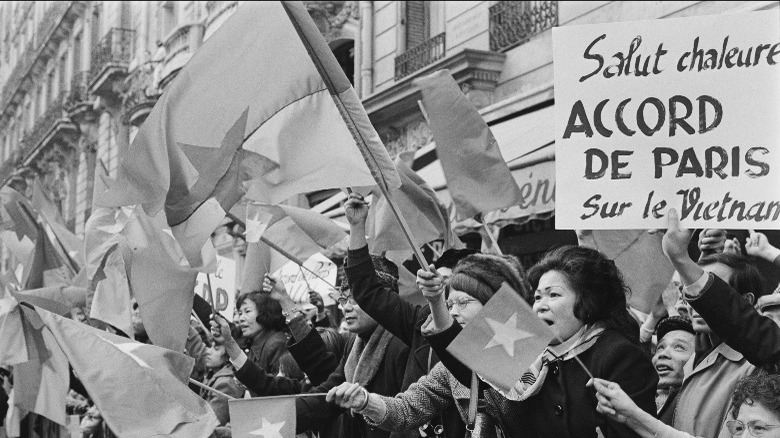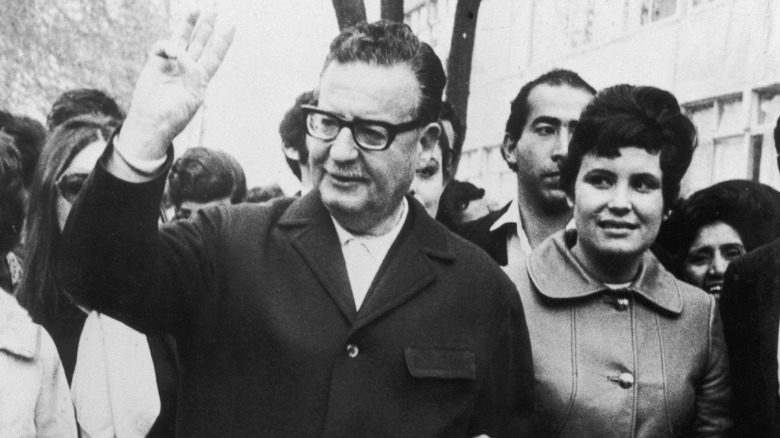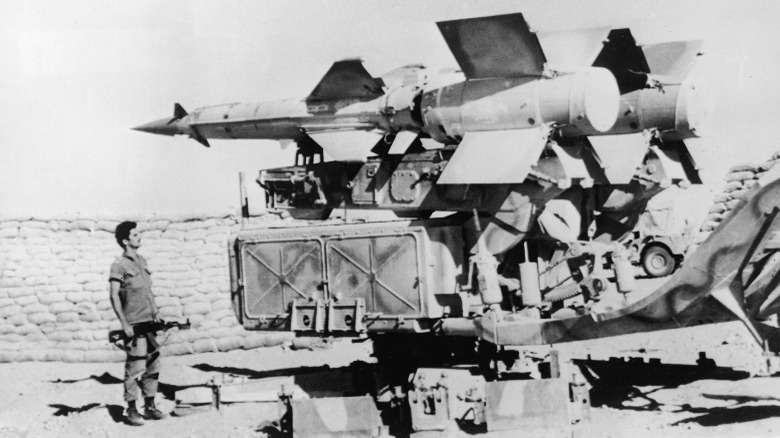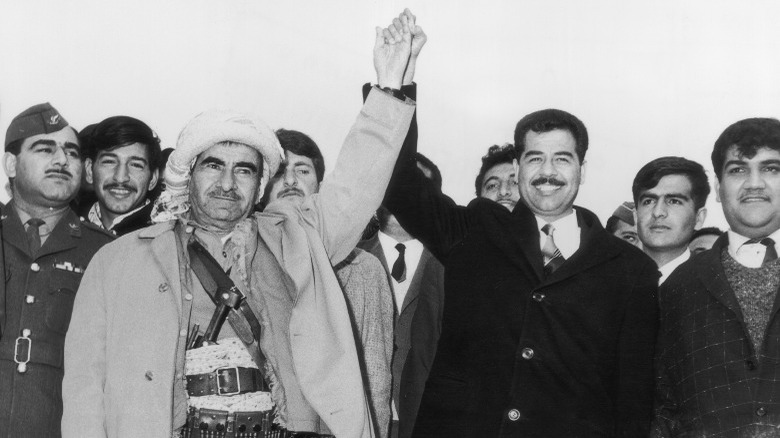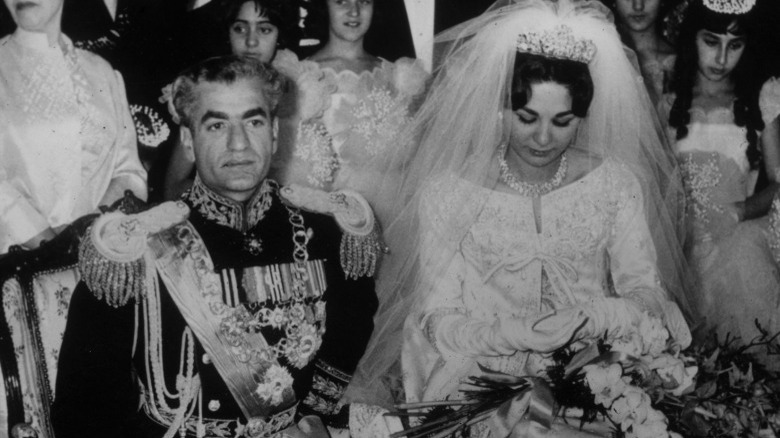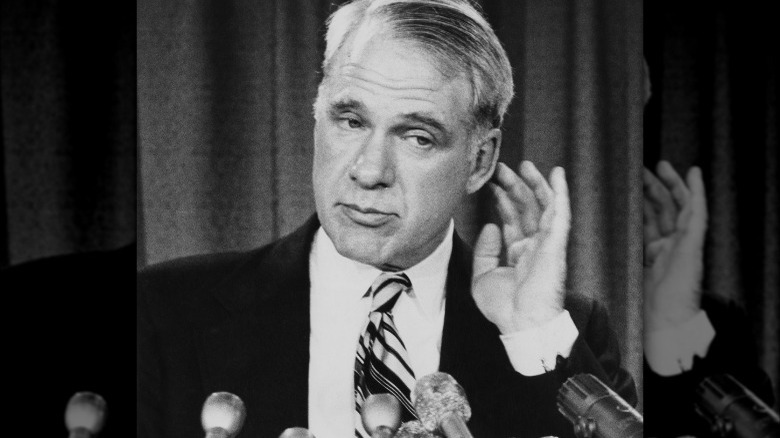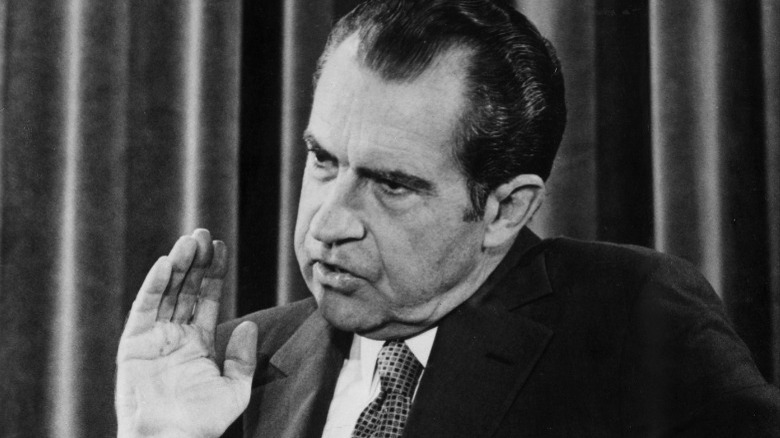Questionable Things About Richard Nixon's Presidency
Richard Nixon was one of the most controversial presidents in United States history. He is the only President ever to resign while in office, and he did so under a massive cloud of suspicion and distrust. Nixon originally was elected to presidential office in 1969, after previously serving as a Congressman and Senator from California from 1947-1953, and as the Vice President from 1953-1961.
While his exit from office was certainly contentious, there were actually a lot of redeeming parts to his presidency. He became the first U.S. President to open diplomatic relations with the communist People's Republic of China, and he signed nuclear arms control treaties with the Soviet Union at the height of the Cold War (via the Miller Center). He also put an end to American involvement in Vietnam and his administration helped negotiate an end to the Yom Kippur War in the Middle East (via the White House).
Still, Nixon is most known for his scandals and missteps, which were plenty. In addition to Watergate, he also illegally spied on Americans, funded Italian terrorists, and supplied massive troves of weapons to one of the most heinous dictators in modern history. These are the questionable things about Richard Nixon's presidency.
The Watergate coverup
Richard Nixon's Watergate scandal is probably the most infamous presidential scandal in U.S. history. Though Nixon would end up resigning over the affair in 1974, it actually started two years prior in 1972 when he was still running for re-election (via History).
During his reelection campaign, in May and June 1972, several members of Nixon's re-election committee broke into the headquarters of the Democratic National Committee (DNC) at the Watergate Hotel in Washington, D.C. They were searching for top-secret documents and attempted to wiretap several of the DNC's devices. It was during their second break-in, on June 17, that they were caught by the police. The scandal immediately hit the newspapers, but voters believed Nixon when he told them he was not involved. However, it quickly came out that he was lying.
According to Tim Weiner in "Legacy of Ashes: The History of the CIA," while there is no definitive evidence that he ordered the break-in, within days he was asking the CIA to shut down the investigation. He also wanted the CIA to scrounge up $1 million in untraceable funds to pay to the jailed burglars for their silence. The Washington Post reported a year later that Nixon and his lawyer had discussed covering up the Watergate scandal more than 30 times together. Much of the reason the scandal came to light was due to the excellent reporting of Bob Woodward and Carl Bernstein, whose anonymous whistleblower "Deep Throat" provided them with the inside information.
The Saturday Night Massacre
When Richard Nixon's henchmen were arrested for burglarizing the Watergate Hotel in early 1972, the police immediately opened an investigation into the incident. Within a year, five people had pleaded guilty and two had been convicted at the trial for the break-in (via History). In May 1973, a special prosecutor, Archibald Cox, was selected to investigate the incident even further (via History). Before the grand jury, several of Nixon's aides acknowledged the existence of a secret taping mechanism that was installed in the Oval Office. Cox knew these recordings would be pertinent to his investigation and immediately tried to get them from Nixon.
However, Nixon stonewalled him and refused to release over 10 hours of recorded material. Then, on October 20, 1973, Nixon fired Cox as special prosecutor of the Watergate investigation (via The Washington Post). He also fired Attorney General Elliot L. Richardson and Deputy Attorney General William D. Ruckelshaus when they refused to carry out his orders to fire Cox. Cox had been vowing to pursue the tapes while Nixon had only agreed to hand over summarized versions of the recordings.
This event later became known as the Saturday Night Massacre. Nixon did end up releasing some of the recordings, but a new special prosecutor was appointed early the next year, and soon seven of his former aides were indicted. Nixon resigned that August amid rising investigations and increasing heat. His successor, Gerald Ford, pardoned Nixon before any charges could be brought against him.
The secret bombing of Cambodia
When Richard Nixon entered the White House in 1969, the United States was deep in its commitment to the Vietnam War. Cambodia, Vietnam's neighbor to the Southeast, was officially supposed to be neutral in the conflict, but the North Vietnamese Army used the border area as a way to smuggle weapons and supplies into the south, shows History. To try and stop the infiltrations, Nixon instituted a new program titled "Operation Menu," which called for the widespread bombing of the Cambodian border area.
The U.S. had already started bombing Cambodia three years earlier in 1965 under the Johnson administration, but Nixon wanted to step things up, according to Bombs Over Cambodia. Though he had promised Congress the bombings would stay within 30 km of the Vietnam border and would try to minimize civilian casualties, by December of 1970, he was asking his Secretary of State Henry Kissinger to ignore those limitations and "go in there and crack the hell out of them."
He started to use the massive B-52 bombers, a step the Johnson administration had refrained from doing. Over a four-year period from March 1969 through August 1973, the Nixon administration dropped over 2.75 million tons of bombs on Cambodia — more than the entire total dropped by the Allies in all of WWII. Fearing backlash, Nixon used a hushed reporting process to keep the bombings as secretive as possible from both the American public and Congress (per History).
His administration illegally spied on Americans
Within a year of taking office, Richard Nixon was spying on and wiretapping American citizens. Soon, his secretary of state Henry Kissinger expanded the surveillance and started using the CIA to spy on even more Americans, argues Tim Weiner in "Legacy of Ashes."
Incredibly, the CIA already had a program in place for spying on private citizens when Nixon and Kissinger entered the White House. It was known as Operation Chaos and was centered around investigating Soviet and Chinese-funded support for the antiwar movement — and it was illegal. However, Kissinger wanted the CIA to go even further than before. He directed the CIA to start directly investigating and spying on American leaders of the antiwar movement. By the end of Chaos, over 300,000 Americans' names were in a CIA database with more than 13,000 files, as reported by The New York Times. Nixon and Kissinger even spied on their own staff.
Other CIA surveillance programs from the Nixon era were Operations Shamrock and Minaret, which were focused on surveilling private cable traffic and Americans who were already on a watch list (via John Prados at the National Security Archive). The Nixon administration also briefly endorsed the Huston Plan, which was a 1970 document compiled by FBI Director J. Edgar Hoover. The Huston Plan targeted domestic groups like student protestors, antiwar activists, members of the Black Panther Party, and communist sympathizers, and recommended restrictions on electronic surveillance be relaxed so they could gather more information.
The failed Paris Peace Accords
One of Richard Nixon's most enduring legacies is that he brought an end to the Vietnam War. In January 1973, just days after beginning his second term in office, Nixon and the United States signed "An Agreement Ending the War and Restoring Peace in Vietnam," also known as the Paris Peace Accords (from History). And while the treaty did bring home all remaining U.S. troops from the country and end the U.S. part in fighting the war, it did little to actually restore any peace to Vietnam.
For his part, Nixon agreed that the U.S. would withdraw all troops from South Vietnam, Laos, and Cambodia, and deconstruct all U.S. military bases in Vietnam. In return, the North Vietnamese would free all prisoners of war being held captive.
However, as argued in "The Cold War: The United States and the Soviet Union, 1917-1991," the treaty had major flaws that ultimately led to South Vietnam's downfall in 1975. To start with, the treaty allowed the North Vietnamese Army to maintain almost 250,000 troops in the South — an obvious recipe for disaster. Nixon also suggested paying a reconstruction fee of $3.25 billion to the North after the war, though this never materialized. The peace treaty was so bad the South Vietnamese president initially refused to sign it until Nixon basically forced him. The North obviously had no intention of adhering to the treaty, which they violated two years later when they conquered the South.
Nixon ordered the 1973 Chilean coup d'etat
In Chile in 1970, a young left-wing politician named Salvador Allende won a plurality in the presidential election. In a short time, he was due to be confirmed as president of Chile by the Chilean Congress (via History). However, Allende's Marxist and Socialist leanings immediately ran afoul of Richard Nixon, and just days after the election Nixon okayed funding for a $10 million CIA program to stop his confirmation.
Yet, as shown in "Overthrow: America's Century of Regime Change From Hawaii to Iraq," the program failed to accomplish its goal, and Allende was confirmed by an overwhelming majority of the Congress and inaugurated that Novemeber. Yet, Nixon refused to let up, and within days the CIA was already striking at Allende. Nixon started by getting $21 million in foreign loans to Chile canceled, something the impoverished country desperately needed. The CIA also started a $3.5 million destabilization program against Allende, which was aided by numerous American companies invested in Chile who were worried about getting pushed out.
By late 1973, the destabilization plan was achieving success. That September, Chilean officers led by Augusto Pinochet ousted Allende in a coup, and Allende died amidst a hailstorm of machine gun fire in the Presidential Palace. Pinochet immediately started rounding up Allende's supporters by the hundreds and executed them (via History). He ruled Chile for 17 more years with an iron fist, torturing and executing thousands more political opponents. Without the Nixon administration, Pinochet may never have come to power.
The Nixon administration supplied weapons during the Yom Kippur War
One of the biggest hot-button issues that Richard Nixon inherited upon entering office was the Arab-Israeli conflict boiling in the Middle East. As soon as they entered the White House in 1969, Nixon and Henry Kissinger immediately started working on a plan to bring peace to the Middle East (as the State Department's Office of the Historian shows). However, either Israel or Egypt rejected the numerous plans the administration presented to them.
By 1972, Nixon and Kissinger were more worried about détente with the Soviet Union and the upcoming election than working on an Israeli-Arab plan. The Egyptians tried to force the Israelis' and Americans' hands in diplomacy, but when that failed, they — along with the Syrian army — attacked Israel on the first day of the 1973 Yom Kippur holiday. Within days the conflict turned international, and the Soviet Union started resupplying the Egyptians and Syrians. In response, the U.S. started airlifting weapons to Israel immediately.
The Soviets and Americans then began diplomatic talks over an Israeli ceasefire, but Kissinger told the Israelis to ignore the ceasefire and continue pushing forward. After another failed ceasefire, the Soviets sent a cryptically worded message about "taking appropriate steps" to end the conflict, and Nixon put the U.S. nuclear forces on high alert. Luckily, the conflict abated before a nuclear holocaust could commence, but it was a very inflammatory showdown that was exacerbated by the Nixon administration's policies.
Abandoning the Kurds in Iran
One of the most questionable parts of Richard Nixon's presidency was his administration's treatment of the Kurds in the early-1970s. According to "Safe For Democracy," the Kurds were a loosely organized group of nomadic tribes spread across northern Iraq and Iran. They were led by Mullah Mustapha Barzani (above left with Saddam Hussein in 1970) and had intermittently fought against both Iran and Iraq since WWII, especially warring with Iraq since the late '50s.
In 1970, Iraq and the Kurds reached a settlement, but the Iranians — wary that the treaty would lead to increased war between Iraq and Iran — urged the Kurds to continue fighting. They agreed to continue fighting only with Nixon's guarantee that the Iranians would not abandon them, which he gave them in Spring 1972. From 1972-1975, the CIA and Iranian government provided over $100 million to the Kurds in their fight against Iraq.
However, at a 1975 meeting in Algiers, Iran and Iraq came to their own treaty on a ceasefire, which prompted the Shah and the U.S. to stop supporting the Kurds (via "The Eagle and the Lion: The Tragedy of American-Iranian Relations"). The Shah allowed the Iraqi army to cross the border unimpeded, where they proceeded to immediately terrorize the Kurds. Barzani sent Kissinger an urgent plea begging for reprieve from "the destruction of our defenseless people in an unprecedented manner," but the administration ignored his plea, abandoning the Kurds to their fate.
Supplying the Shah with F-14 Tomcats
It might be hard to believe now, but prior to 1979, the United States and Iran were very strong allies with incredibly robust diplomatic relations. Before the 1979 Iranian Revolution, the Shah (pictured above) ruled Iran as a ruthless dictator through a regime of terror (as shown in "The Eagle and the Lion"). Political show trials became normalized, dissidents would randomly disappear from their homes and villages without a trace, and the Shah and his Prime Minister openly admitted to torturing political opponents through his secret police known as SAVAK. Amnesty International even chastised Iran for having the worst record for human rights in the entire world.
However, none of this prevented Richard Nixon from entering into a massive arms deal with him in 1972. That May, Nixon and Henry Kissinger visited the Shah in Iran and essentially gave him carte blanche and a blank check to buy any conventional weapons he wanted from the U.S. The Shah particularly wanted the U.S. Navy's new F-14 Tomcat fighter jets. The Pentagon specifically told Nixon not to sell the Shah the F-14, F-15, or any laser-guided bombs — which Nixon and Kissinger promptly ignored. Due to surging oil revenues, the Shah bought more than $16 billion in weapons from the U.S., including several F-14s.
Now Iran and the U.S. are bitter enemies, but Iran still maintains their fleet of F-14 Tomcats — much to the chagrin of the U.S. military (via 19FortyFive).
Appointing James Schlesinger as director of the CIA
In early 1973, fresh off his victory in the 1972 Presidential election, Richard Nixon resolved to get rid of one of his biggest nemeses in the CIA: its director Richard Helms. Nixon had long despised Helms and the CIA, who he thought was out to get him and whom he blamed for his loss in the 1960 Presidential election to John F. Kennedy (according to Tim Weiner in "Legacy of Ashes"). That March, Nixon fired Helms from the agency, which Helms believed was due to his reluctance to use the CIA to compromise the Watergate investigation.
In his place Nixon appointed James Schlesinger, who lasted for all of 17 weeks. As Weiner describes it, "The collapse of the CIA as a secret intelligence service began on the day Helms left and James Schlesinger arrived at headquarters." Schlesinger jettisoned more than 500 analysts from the agency and over 1,000 from the clandestine service –– including some who were currently stationed overseas on secret missions. He allowed himself to be manipulated by CIA spy James Angleton, who convinced him that the Soviets had penetrated the agency years before and had eyes and ears on the inside.
After less than five months, Schlesinger left the CIA to become Nixon's Secretary of Defense as the administration slowly started to crumble under the weight of Watergate.
Working with the 1970s Greek Government
Supporters of Richard Nixon's foreign policy often point to his work towards détente with the Soviet Union and inaugurating the opening of diplomatic relations with the People's Republic of China. And while those are certainly notable achievements, not all of his diplomatic relationships were quite as positive. Case in point: Nixon's buddies in the Greek junta that ruled Greece during his first term.
As the Greek Reporter shows, in 1967 one of Greece's most unpopular governments took over following a coup d'état. Incredibly, according to "Legacy of Ashes," the CIA had previously been supporting various Greek governments for years, but they withdrew some of their support after the 1967 coup. However, the channel of communication reopened when Nixon took over the presidency in 1969, partly because the same generals who ran the coup had illegally funded his 1968 presidential campaign.
As the channel of communication reopened, so did the secret Greek funding of Nixon and his Vice President Spiro Agnew — who was a Greek American himself. In 1974, the Greek junta launched a war against fellow NATO member Turkey on the co-inhabited island of Cyprus, and deliberately lied to the CIA and Nixon administration prior to launching the first attacks. Tensions in Greece over the Cyprus war led to the death of an American ambassador and CIA station chief, who were both shot dead in Athens.
